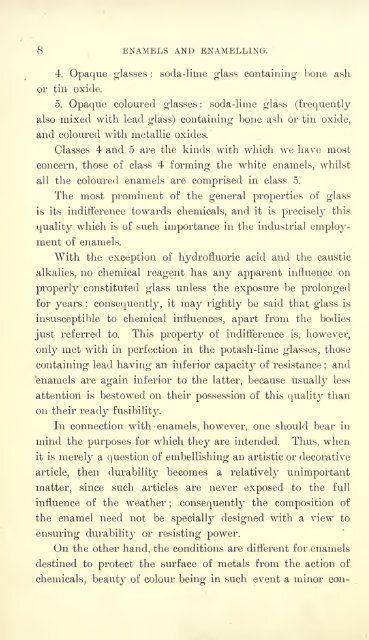Enamels and enamelling; an introduction to the preparation and ...
Enamels and enamelling; an introduction to the preparation and ...
Enamels and enamelling; an introduction to the preparation and ...
Create successful ePaper yourself
Turn your PDF publications into a flip-book with our unique Google optimized e-Paper software.
8 ENAMELS AND ENAMELLING.<br />
4. Opaque glasses : soda<br />
or tin oxide.<br />
-lime glass containing bone ash<br />
5. Opaque coloured glasses : soda-lime glass (frequently<br />
also mixed with lead glass) containing bone ash or tin oxide,<br />
<strong><strong>an</strong>d</strong> coloured with metallic oxides.<br />
Classes 4 <strong><strong>an</strong>d</strong> 5 are <strong>the</strong> kinds with which we have most<br />
concern, those of class 4 forming <strong>the</strong> white enamels, whilst<br />
all <strong>the</strong> coloured enamels are comprised in class 5.<br />
The most prominent of <strong>the</strong> general properties of glass<br />
is its indifference <strong>to</strong>wards chemicals, <strong><strong>an</strong>d</strong> it is precisely this<br />
quality which is of such import<strong>an</strong>ce in <strong>the</strong> industrial employment<br />
of enamels.<br />
With <strong>the</strong> exception of hydrofluoric acid <strong><strong>an</strong>d</strong> <strong>the</strong> caustic<br />
alkalies, no chemical reagent has <strong>an</strong>y apparent influence on<br />
properly constituted glass unless <strong>the</strong> exposure be prolonged<br />
for years: consequently, it may rightly be said that glass is<br />
insusceptible <strong>to</strong> chemical influences, apart<br />
from <strong>the</strong> bodies<br />
just referred <strong>to</strong>. This property of indifference is, however,<br />
only met with in perfection in <strong>the</strong> potash-lime glasses, those<br />
containing lead having <strong>an</strong> inferior capacity of resist<strong>an</strong>ce ;<br />
<strong><strong>an</strong>d</strong><br />
enamels are again inferior <strong>to</strong> <strong>the</strong> latter, because usually less<br />
attention is bes<strong>to</strong>wed on <strong>the</strong>ir possession of this quality th<strong>an</strong><br />
on <strong>the</strong>ir ready fusibility.<br />
In connection with enamels, however, one should bear in<br />
mind <strong>the</strong> purposes for which <strong>the</strong>y are intended. Thus, when<br />
it is merely a question of embellishing <strong>an</strong> artistic or decorative<br />
article, <strong>the</strong>n durability becomes a relatively unimport<strong>an</strong>t<br />
matter, since such articles are never exposed <strong>to</strong> <strong>the</strong> full<br />
influence of <strong>the</strong> wea<strong>the</strong>r ; consequently <strong>the</strong> composition of<br />
<strong>the</strong> enamel need not be specially designed with a view <strong>to</strong><br />
ensuring durability or resisting power.<br />
On <strong>the</strong> o<strong>the</strong>r h<strong><strong>an</strong>d</strong>, <strong>the</strong> conditions are different for enamels<br />
destined <strong>to</strong> protect <strong>the</strong> surface of metals from <strong>the</strong> action of<br />
chemicals, beauty of colour being in such event a minor con-
















